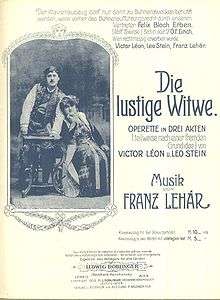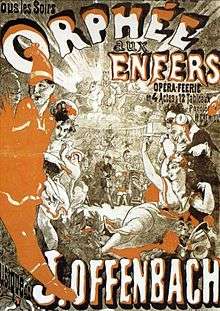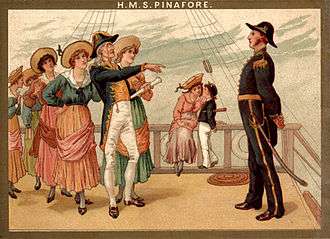Operetta
Operetta is a form of theatre and a genre of light opera, light in terms of both music and subject matter. It includes spoken dialogue, songs, and dances. "Operetta" is the Italian diminutive of "opera" and was used originally to describe a shorter, perhaps less ambitious work than an opera.[1] Operetta became a recognizable form in the mid-1800s in France, and its popularity led to the development of many national styles of operetta.[1] Operetta as a genre lost favor in the 1930s and gave way to modern musical theatre.[2] Important operetta composers include Johann Strauss, Jacques Offenbach and Franz Lehar.

Definition
Mozart, who is often credited with the first use of the word operetta, defined it as a form for "certain dramatic abortions, those miniature compositions in which one finds only cold songs and couplets from vaudeville."[3] The definition of operetta has changed over the centuries and ranges depending on each country's history with the genre.[2]

However, there are some common characteristics among operettas that flourished from the mid-1850s through the early 1900s, beginning with the French opéra-bouffe.[4] They contain spoken dialogue interspersed between musical numbers, and often the principal characters, as well as the chorus, are called upon to dance, although the music is largely derived from 19th-century operatic styles, with an emphasis on singable melodies.[1] Operettas are usually shorter than operas, and are usually of a light and amusing character.[5]
Operetta is a precursor of the modern musical theatre or the "musical"[6] In the early decades of the 20th century, operetta continued to exist alongside the newer musical, with each influencing the other.
Operetta in French
Origins
Various national styles preceded the operetta, including the Italian intermezzos, the most famous of which is Pergolesi's La serva padrona, as well as the English tradition of ballad operas.[7] Operetta flourished in France around the middle of the 19th century, to satisfy a need for short, light works in contrast to the full-length entertainment of the increasingly serious opéra comique.[1][4] By this time, the "comique" part of the genre name had become misleading: Georges Bizet's Carmen (1875) is an example of an opéra comique with a tragic plot. The definition of "comique" meant something closer to "humanistic," meant to portray "real life" in a more realistic way, representing tragedy and comedy next to each other, as Shakespeare had done centuries earlier. With this new connotation, opéra comique had dominated the French operatic stage since the decline of tragédie lyrique.
Hervé (1825–1892), né Florimond Ronger, is often identified as the grandfather of operetta. He was a singer, composer, librettist, conductor, and scene painter. In 1842, he wrote the one act opérette, L'Ours et le pacha, based on the popular vaudeville by Eugène Scribe and X. B. Saintine. In 1848, Hervé made his first notable appearance on the Parisian stage, with Don Quichotte et Sancho Pança (after Cervantes), which can be considered the starting point for the new French musical theatre tradition. Hervé's most famous works are the Gounod-parody Le petit Faust (1869) and Mam'zelle Nitouche (1883).[7]

Jacques Offenbach is most responsible for the development and popularization of operetta—also called opéras bouffes or opérettes—giving it its enormous vogue during the Second Empire and afterwards.[1] In 1849, Offenbach obtained permission to open the Théâtre des Bouffes Parisiens, a theatre company that offered programs of two or three satirical one-act sketches. The company was so successful that it led to the elongation of these sketches into an evening's duration.[1] Offenbach's productions were, however, bound by the police prefecture in Paris, which specified the type of performance that would be allowed: “pantomimes with at most five performers, one-act comic musical dialogues for two to three actors, and dance routines with no more than five dancers; choruses were strictly forbidden.”[3] These rules defined what came to be defined as operetta: “a small unpretentious operatic work that had no tragic implications and was designed to entertain the public.”[3]
The limitations placed on Offenbach and Parisian theatre were gradually lifted, and operetta gained wide popularity. While Offenbach's earliest one-act pieces included Les deux aveugles, Le violoneux and Ba-ta-clan (all 1855) did well, his first full-length operetta, Orphée aux enfers (1858), was by far the most successful. It became the first repertory operetta and was staged hundreds of times across Europe and beyond.[3] Offenbach wrote more than 100 operettas.[8] By the 1870s, however, Offenbach's popularity declined. The public showed more interest in romantic operettas that showed the “grace and refinement” of classical music. This included Messager's operetta Véronique and Louis Ganne's Les saltimbanques.
The 20th century found French operetta even more out of favor as the international public turned to Anglo-American and Viennese operettas.
Operetta in German
Offenbach was unabashed about spreading operetta around the continent. In 1861, he staged some of his recent works at the Carltheater in Vienna, which paved the way for Austrian and German composers. Soon, Vienna became the epicenter of operetta productions.[3] It is the Viennese operette, not the French, that is the first time the term is used to describe a full-length work.[1] Additionally, after the Prussian defeat in 1866, operetta became the sign of a new age in Austria, marked by modernity and industrialization.[9]
Austria–Hungary
The most significant composer of operetta in the German language was the Austrian Johann Strauss II (1825–1899). Strauss was recruited from the dance hall and introduced a distinct Viennese style to the genre.[1] His first operetta was Indigo und die vierzig Räuber (1871). His third operetta, Die Fledermaus (1874), became the most performed operetta in the world, and remains his most popular stage work. In all, Strauss wrote 16 operettas and one opera, most with great success when first premiered.[1]
Strauss's operettas, waltzes, polkas, and marches often have a strongly Viennese style, and his popularity causes many to think of him as the national composer of Austria. The Theater an der Wien never failed to draw huge crowds when his stage works were first performed. After many of the numbers the audience would call noisily for encores.
Following the death of Johann Strauss and his contemporary, Franz von Suppé, Franz Lehár was the heir apparent. Lehar is widely considered the leading operetta composer of the 20th century and his most successful operetta, Die lustige Witwe (The Merry Widow), is one of the classic operettas still in repertory.[10]
The Viennese tradition was carried on by Oscar Straus, Carl Zeller, Karl Millöcker, Leo Fall, Richard Heuberger, Edmund Eysler, Ralph Benatzky, Robert Stolz, Emmerich Kálmán, Nico Dostal, Fred Raymond, Igo Hofstetter and Ivo Tijardović in the 20th century.
Germany
.jpg)
In the same way that Vienna was the center of Austrian operetta, Berlin was the center of German operetta. Berlin operetta often had its own style, including, especially after World War I, elements of jazz and other syncopated dance rhythms, a transatlantic style, and the presence of ragged marching tunes. Berlin operettas also sometimes included aspects of burlesque, revue, farce, or cabaret.
Paul Lincke pioneered the Berlin operetta in 1899 with Frau Luna, which includes "Berliner Luft" ("Berlin Air"),[11] which became the unofficial anthem of Berlin. His Lysistrata (1902) includes the song and tune "The Glow-Worm", which remains quite popular internationally. Much later, in the 1920s and 1930s, Kurt Weill took a more extreme form of the Berlin operetta style and used it in his operas, operettas, and musicals.
The Berlin-style operetta coexisted with more bourgeois, charming, home-loving, and nationalistic German operettas – some of which were called Volksoperetten (folk operettas). A prime example is Leon Jessel's extremely popular 1917 Schwarzwaldmädel (Black Forest Girl).[12] These bucolic, nostalgic, home-loving operettas were officially preferred over Berlin-style operettas after 1933, when the Nazis came to power and instituted the Reichsmusikkammer (State Music Institute), which deprecated and banned "decadent" music like jazz and similar "foreign" musical forms.
Notable German operetta composers include Paul Lincke, Eduard Künneke, Walter Kollo, Jean Gilbert, Leon Jessel, Rudolf Dellinger, Walter Goetze and Ludwig Schmidseder.
Operetta in English
Offenbach's influence reached England by the 1860s. Arthur Sullivan, of the Gilbert and Sullivan duo, composed Cox and Box (1866) as a direct reaction to Offenbach's Les deux aveugles (1855).[1] Gilbert and Sullivan solidified the format in England with their long-running collaboration during the Victorian era. With W. S. Gilbert writing the libretti and Sullivan composing the music, the pair produced 14 comic operas, which were later called Savoy Operas. Most were enormously popular in Britain, the U.S., and elsewhere. Sullivan and Gilbert and their producer Richard D'Oyly Carte themselves call their joint works comic operas to distinguish this family-friendly fare from the risqué French operettas of the 1850s and 1860s.[13] Their works, such as H.M.S. Pinafore, The Pirates of Penzance and The Mikado, continue to enjoy regular performances throughout the English-speaking world.[14]
English operetta continued into the 1890s, with works by composers such as Edward German, Ivan Caryll and Sidney Jones. These quickly evolved into the lighter song-and-dance pieces known as Edwardian musical comedy. Beginning in 1907, with The Merry Widow, many of the Viennese operettas were adapted very successfully for the English stage. To explain this phenomenon, Derek Scott writes,
In January 1908, London’s Daily Mail claimed that The Merry Widow had been performed 450 times in Vienna, 400 times in Berlin, 350 times in St Petersburg, 300 times in Copenhagen, and was currently playing every evening in Europe in nine languages. In the USA, five companies were presenting it, and ‘the rush for tickets at the New Amsterdam Theatre’ was likened to ‘the feverish crowding round the doors of a threatened bank’.2 Stan Czech, in his Lehár biography, claims that by 1910 it had been performed ‘around 18,000 times in ten languages on 154 American, 142 German, and 135 British stages’.[15]
The international embrace of operetta directly correlated with the development of both the West End in London and Broadway in New York.[15] American audiences were first introduced to operetta through Gilbert and Sullivan's H.M.S. Pinafore in 1878.[16] American operetta composers included Victor Herbert, whose works at the beginning of the 20th century were influenced by both Viennese operetta and Gilbert and Sullivan.[17] He was followed by Sigmund Romberg and Rudolph Friml. Nevertheless, American operetta largely gave way, by the end of World War I, to musicals, such as the Princess Theatre musicals, and revues, followed by the musicals of Rodgers and Hart, Cole Porter, Irving Berlin and others.
References
Informational notes
Citations
- Lamb, Andrew (2001). "Operetta" Check
|url=value (help). https://www-oxfordmusiconline-com. doi:10.1093/gmo/9781561592630.article.20386. Retrieved 2019-09-27. - Traubner, Richard (2004-06-01). Operetta. doi:10.4324/9780203509029. ISBN 9780203509029.
- Sorba, Carlotta (2006-09-01). "The origins of the entertainment industry: the operetta in late nineteenth-century Italy". Journal of Modern Italian Studies. 11 (3): 282–302. doi:10.1080/13545710600806730. ISSN 1354-571X.
- Gänzl, Kurt. "Toperettas: the history of operetta in ten works", Bachtrack.com, 22 October 2019
- Grout, Donald Jay & Williams, Hermine Weigel (2013). A Short History of Opera. Columbia University Press. p. 378. ISBN 978-0231507721. Retrieved 2 May 2015.
- Jones, J. Bush (2003) Our Musicals, Ourselves, pp. 10–11, 2003, Brandeis University Press: Lebanon, N.H. ISBN 1584653116
- "The Merry Widow Lesson: What's Operetta, Doc?". Utah Opera. 2016-01-05. Retrieved 2019-09-28.
- "The beginner's guide to operetta | English National Opera". Retrieved 2019-09-28.
- Crittenden, Camille. (2006). Johann Strauss and Vienna : operetta and the politics of popular culture. Cambridge University Press. ISBN 0521027578. OCLC 443368102.
- Lamb, Andrew (2001). "Franz Lehar" Check
|url=value (help). https://www-oxfordmusiconline-com. doi:10.1093/gmo/9781561592630.article.16318. Retrieved 2019-09-27. - "Berliner Luft" conducted by Plácido Domingo with the Berlin Philharmonic
- Lamb, Andrew. 150 Years of Popular Musical Theatre. Yale University Press, 2001. p. 203.
- Jacobs 1984, introductory note on nomenclature
- See Bradley, Ian (2005). Oh Joy! Oh Rapture! The Enduring Phenomenon of Gilbert and Sullivan. Oxford University Press. ISBN 0-19-516700-7. and Hewett, Ivan (2 August 2009) "The Magic of Gilbert and Sullivan". The Telegraph. Retrieved 14 April 2010.
- Scott, Derek B. (2019-06-27). German Operetta on Broadway and in the West End, 1900–1940. Cambridge University Press. doi:10.1017/9781108614306. ISBN 9781108614306.
- Bordman, Gerald (1981). American Operetta. New York: Oxford University Press.
- Ledbetter, Steven. "Victor Herbert", Grove Music Online ed. L. Macy, accessed February 11, 2009 (subscription required)
Bibliography
- Jacobs, Arthur (1984). Arthur Sullivan: A Victorian Musician. Oxford University Press. ISBN 0-19-315443-9.CS1 maint: ref=harv (link)
Further reading
- Bordman, Gerald (1981) American Operetta. New York: Oxford University Press.
- Clarke, Kevin (2007) Glitter and be Gay: Die authentische Operette und ihre schwulen Verehrer. Hamburg: Männerschwarm Verlag.(German)
- Ganzl, Kurt (2001) The Encyclopedia of Musical Theatre (3 Volumes). New York: Schirmer Books.
- Goulet, Charles (1981) Sur la scène et dans la coulisse. Québec, Qc.: Ministère des Affaires culturelles. ISBN 2-551-04178-3
- Linhardt, Marion (2006) Residenzstadt und Metropole. Zu einer kulturellen Topographie des Wiener Unterhaltungstheaters (1858–1918). Berlin: Max Niemeyer Verlag. (German)
- Traubner, Richard (1983) Operetta: A Theatrical History. Garden City, New York: Doubleday.
- Viagrande, iccardo (2009) Tu che m'hai preso il cuor. Un viaggio nel mondo dell'operetta. Monza: Casa Musicale Eco. (Italian)
External links
| Wikimedia Commons has media related to Operetta. |
- Extensive site with information about operettas, light operas and their composers
- Essay on operettas of Offenbach, Johann Strauss Jr. and their contemporaries
- Operetta Research Center (with a large archive of historical reviews)
.jpg)
